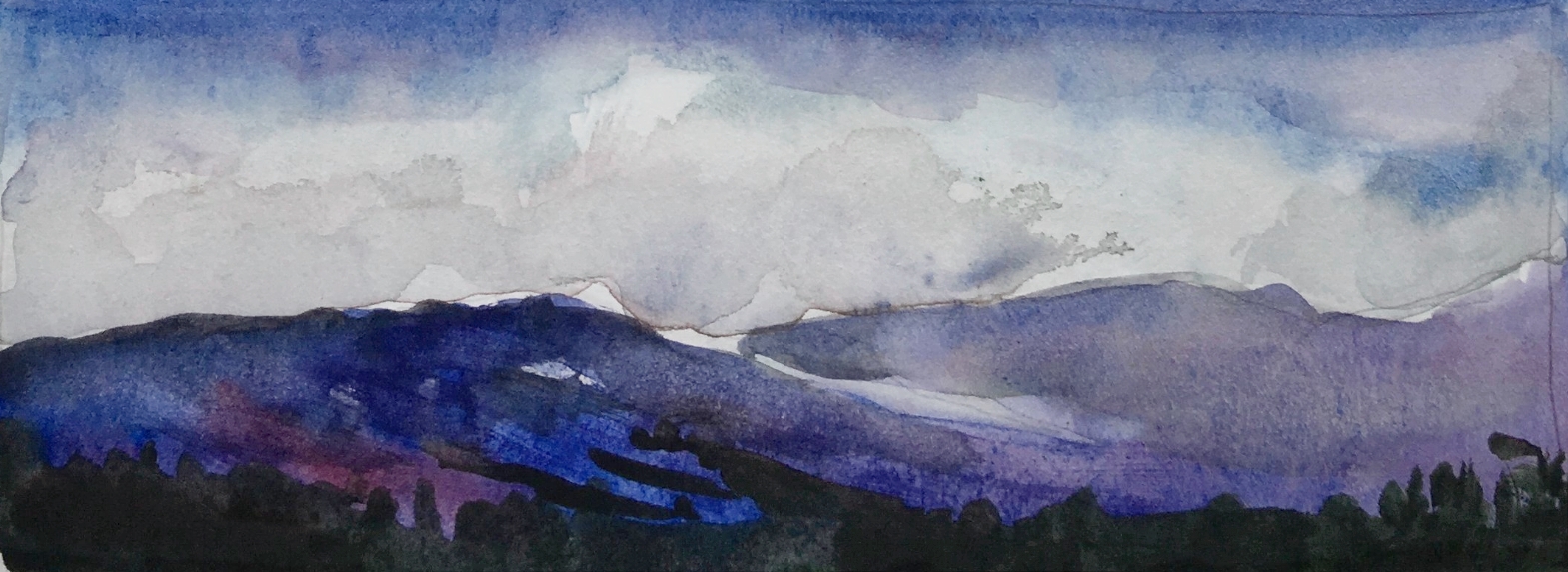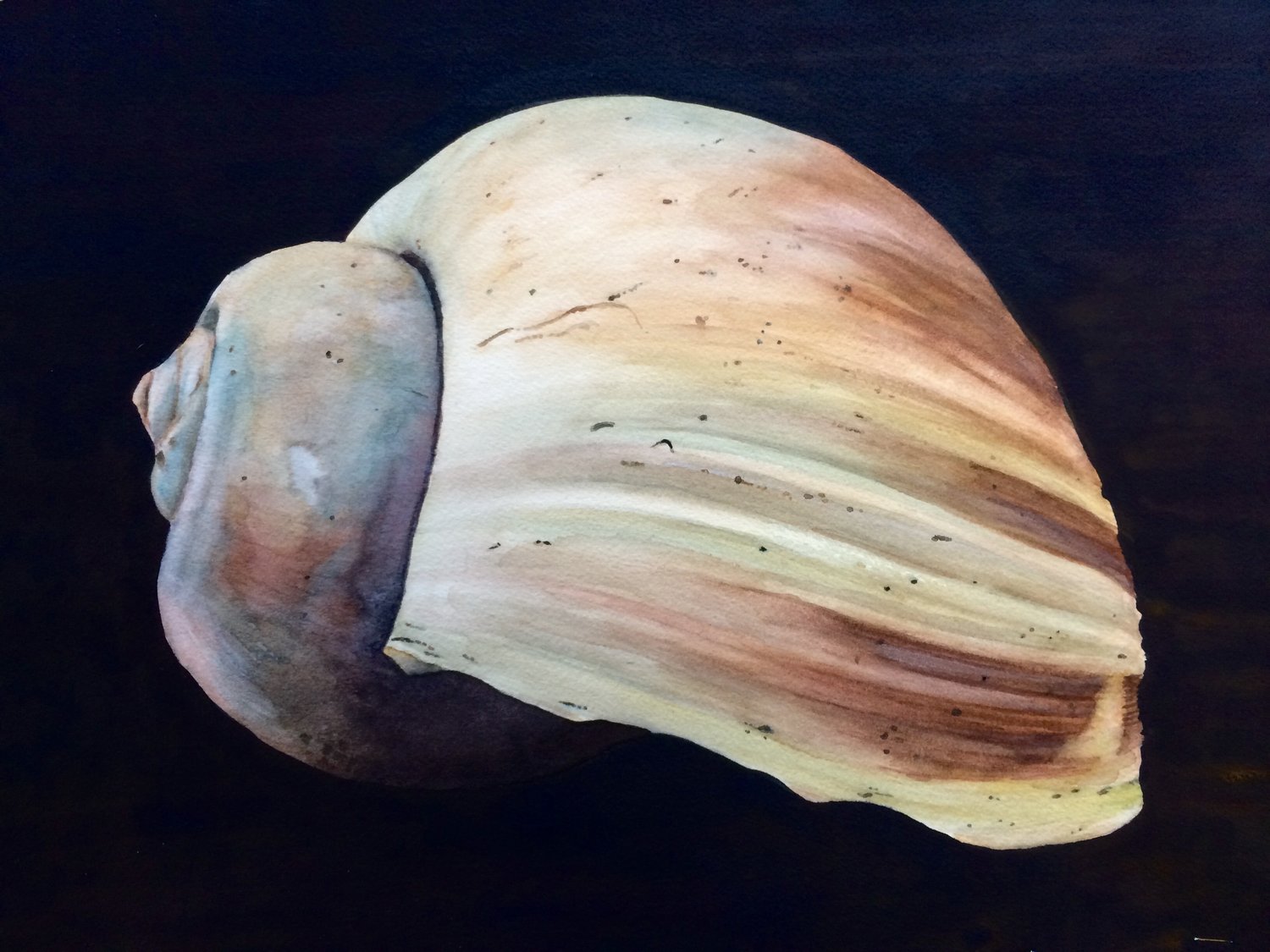Temperature refers to the warmth or coolness of a color. A color’s temperature affects the color of everything we see. And as artists, it’s important to learn about it because color temperature helps us create depth, mood and even movement. In general, yellows, oranges, and reds are warm colors and blues and greens are cool.
Warm colors appear to advance, or come forward, while cool colors appear to recede or go back in space. This is because the wavelengths of warm colors are longer so your eyes see them sooner than the shorter wavelengths of cooler colors. Using warm colors in the foreground of a painting and cool colors in the background of a painting can help create the illusion of three dimension and distance, such as in my painting below. The daisy and bee seem to come forward in their warm tones, while the background, all cool tones, seems to recede.
The illusion of advancing or receding helps create a sense of form in smaller subjects, not just landscapes. For example, in this watercolor of a shell, the bigger shape of the shell is warm (yellows and reddish browns) and comes forward, while I painted the smaller shape of the shell cool (blue) and it appears to be further back than the warm shape of the shell.
Generally when the light source is warm, the shadows will be cool. When the light source is cool, the shadows will be warm.
Creating warm/cool contrasts can also add a wow factor at your focal point. This watercolor I painted of a candy display plays with temperature contrasts and it has a dazzling effect.
Looking at the color wheel, red-orange is the warmest color. When you move away from it in either direction, the colors will appear cooler and cooler, until you get to blue-green, which is the coolest color. As you move away from blue-green in either direction, the colors will appear to get warmer and warmer, until you are back to red-orange again. That sounds simple. But…
Color temperature is relative. A color that might appear warm next to one color, could appear cool next to a different color. Also, every color has a tendency towards either warm or cool. We say yellow is a warm color, but some yellows tend towards red (so you will see warmer tones in it) while others tend towards blue (which are cooler tones).
For example:
Rose Madder Genuine and Alizarin Crimson are cool reds. Cadmium Red and Light Red are warm reds, because they lean more toward yellow. Aureolin Yellow is slightly cool when compared with Cadmium Yellow. French Ultramarine is a warm blue. Cobalt Blue is slightly cool.
And neutral colors and earth tones, while typically appearing cooler because they are low intensity, still have differences in color temperature from one to the next.
The more we start to see these nuances in color temperature the better we will be at mixing colors as well since to create brilliant color you should mix colors that lean towards the same temperature.
It’s also important to aim for a temperature dominance in your paintings. Avoid equal amounts of cools and warm colors as it creates an unappealing result. It's fine to have both warm and cool colors in your artwork, but not in equal amounts. Choose whether the dominant temperature will be warm and cool and be sure you use more of those colors.
Seeing temperature in color takes practice. Here's an exercise to get you started.
Sketch the same scene four times.
In the first version, paint it using only cool colors.
In the second version, paint it using only warm colors.
In the third, paint predominately in one temperature with just a bit of the other temperature.
In the fourth version, paint it roughly half cool colors and half warm colors.
Study the differences in mood, sense of depth, interest, personal preference. You are on your way to understanding color temperature!
I am offering the workshop Understanding Colors for the Watercolorist, to start in January! It will be held at Cloud 9 Art School in Bothell.
Wednesdays 10am- 12:30pm
January 8 - February 26, 2020
Designed to help watercolor artists understand both color theory and paint properties, we will explore the properties of watercolor pigments (transparent, opaque, staining, fugitive, granulating, on my!) and we will look at different ways of mixing color (on the palette, on the paper, wet-into-wet, glazing). We will experiment with color temperature, value, and intensity of pigments. We will learn about the advantages of painting with a limited palette and we will make a lot of color charts in the process.
We will play with formulas that work well for specific subjects (skies, skin, shadows). We will explore how to match colors and study classic compatible palettes (colors that work well together in a painting). We will look at the emotions of colors and explore the use of color through art history.
Each of the lessons of our workshop will introduce new ideas and exercises, new paints, techniques, and challenge you to think about color in new ways. You will get a creative workout, but in a relaxed, supportive setting, where experimentation and play are encouraged while techniques and observation are emphasized.
For more information and to register please visit
www.charlenecollinsfreeman.com/workshops/
Color in a picture is like enthusiasm in life. - Vincent van Gogh




